|
Alex Raymond
and the Right Stuff
Among the
achievements for which Alex Raymond is noted in histories of this oft-abused
artform is that he drew three nationally syndicated comic strips
simultaneously. Jungle Jim and Flash Gordon, both of which began
January 7, 1934, and Secret Agent X-9, which began two weeks later on
January 22. Given the high quality of the illustrative evidence available,
Raymond’s achievement seems all the more remarkable. To do such good work on
three comic strips at the same time attests, we are tempted to say, to
Raymond’s towering graphic genius.
Before
surrendering to the temptation, however, we might take a moment to reflect, and
in that moment, remember that Secret Agent X-9 was a daily only comic
strip and Jungle Jim and Flash Gordon appeared only on Sundays.
Moreover, Jungle Jim was the “topper” for Flash Gordon—a one- or
two-tier strip that filled out a single page, with Flash occupying the
bottom two-thirds. The two Sunday-only strips made up a single page of the
funnies, just as Bringing Up Father and Snookums or Blondie and Colonel Potterby and the Duchess did. Raymond may have drawn better
(more illustratively, in greater detail), but he did no more work in an average
week than George McManus did with Jiggs and Maggie or Chic Young with
Blondie and Dagwood. Six daily strips and one Sunday page.
Raymond
has enjoyed an unremitting and entirely deserved chorus of acclaim, but,
according to most versions of his life and career, it is his skill as an
illustrator that entitles him to this idolatry, not the quantity of his work.
And Raymond earned a secure place in the history of the medium solely as an
illustrator of other men’s stories. As such, he was not, strictly speaking, a
cartoonist: a cartoonist (by definition—mine anyway) both draws and writes his
material, and all of the great strips with which Raymond’s name is associated
were reportedly written by others. Even Raymond’s post-war undertaking, Rip
Kirby, was supposedly written by others, chiefly Raymond’s editors at King
Features in concert with Raymond. Or so the story goes; we’ll take another look
later on.
Even
though Raymond’s consumate artistry elevated the strips above the mundane, they
were not all of equal excellence. Flash Gordon, which was intended to be
King’s competition for Buck Rogers, is unquestionably Raymond’s
masterpiece. His great skill in executing the other strips magnified his impact
upon the profession, but neither of the other two of his initial trio of strips
was particularly distinguished as a comic strip.
Secret
Agent X-9, devised by King to capitalize upon the popularity of Chester
Gould’s cop strip, Dick Tracy, and a variation thereof in Norman
Marsh’s Dan Dunn, was written, for most of Raymond’s stint on it, by
a celebrated writer of hardboiled detective fiction, Dashiell Hammett. When
Hammett quit, Raymond reportedly wrote it himself for a brief time, then
another mystery writer, Leslie Charteris, took over. Neither Raymond nor
Charteris proved very good at writing a comic strip.
As
I’ve said elsewhere (in a book of mine, The Art of the Funnies), despite
Raymond’s great talent as an illustrator, his deployment of the comic strip
medium was undistinguished. The plots of the two X-9 adventures presumed
to have been written by Raymond stumble along with motiveless actions, and
narrative breakdown leap-frogs from one event to another, continuity gaps
filled in with huge chunks of prose narration. Both these adventures rush to
conclusion, much of the action taking place “off stage” so that it must be
narrated to us in captions, weakening the drama of events.
Raymond’s X-9 strips often lack the variety of panel composition—such things as
varying camera angles and distances—that would lend visual drama to the story.
Compared, say, to Milton Caniff’s work on Terry and the Pirates a
short time later, much of Raymond’s X-9 seems a monotonous parade of
panels in which the characters appear always the same size, always seen from
the same angle. Moreover, Raymond’s people never change expression: X-9's grim
albeit handsome visage seems carved in stone, and his facial expression is
repeated on the head of every male character in the strip. And Raymond’s
representation of his hero grates a little: his X-9 is a bit too dapper, more
of a fashion model than a street fighter.
Raymond’s
women, although superbly drawn and seductively beautiful, all look alike, and
when he makes both young women in a story dark-haired, we can’t tell one from
the other—with much resulting confusion about the story’s plot (particularly
after Hammett had left).
Raymond
fared much better on the Sunday pages. The mode of storytelling there—by weekly
installment—lends itself to his illustrator’s skills without revealing his
failings as a visual storyteller. And on the Sunday page, Raymond had more room
in which to exercise his graphic skills.
But
it was more than format that fired Raymond’s imagination. Jungle Jim alone, although every bit as well-drawn as Flash, would not have secured
Raymond a place in the pantheon of cartooning’s greatest practitioners.
Concocted, we assume, as King’s answer to Tarzan, the strip followed the
exploits of a hunter named Jim Bradley as he righted wrongs in the jungles of
southeast Asia.
But
Raymond’s heart was clearly not in this work: after a couple of years, his
pictures appear almost dashed-off. For weeks in mid-1936, the strip’s panels
were almost wholly devoid of 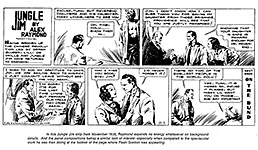 background detail. The strip consisted entirely of
pictures of Jim and the other characters talking.They are all attractively drawn. Raymond’s
technical virtuosity was so great that his figure-drawing alone rescues the
strip visually. But he was obviously not putting much work into the feature.
His effort—his creative energy, his imagination and skill and dedication—was
being poured into the feature at the bottom two-thirds of the Sunday page, Flash
Gordon. background detail. The strip consisted entirely of
pictures of Jim and the other characters talking.They are all attractively drawn. Raymond’s
technical virtuosity was so great that his figure-drawing alone rescues the
strip visually. But he was obviously not putting much work into the feature.
His effort—his creative energy, his imagination and skill and dedication—was
being poured into the feature at the bottom two-thirds of the Sunday page, Flash
Gordon.
THE GRAPHIC
EXCELLENCE that would distinguish Flash Gordon did not spring,
full-blown, from Raymond’s pen with the strip’s debut. At first, he drew in
the same unembellished linear illustrative style he had used when ghosting Tim
Tyler’s Luck for Lyman Young in 1933. But before long, he began to
feel the influence of other styles of illustration, and the artwork in Flash started to change.
In
using the work of other artists as models for changing his style, Raymond was
scarcely unique. Most artists are influenced by what their colleagues do, and
they borrow freely this technique and that. When the borrowing is well done,
however, it goes beyond mere imitation and gives to the borrower’s work a new
dimension wholly his own. His work becomes an amalgam of all he has borrowed,
unified by a single creative consciousness into something uniquely his—his own
style.
It
is not clear who influenced Raymond’s emerging style the most, although there
are several candidates, and he probably borrowed a little from them all (and
from others we don’t know about). In rendering the futuristic architecture of
Mongo, Raymond was obviously imitating Franklin Booth, a
turn-of-the-century artist. And comics historian Ron Goulart notes that
Raymond’s contemporaries, Matt Clark and John LaGatta, also
supplied models that he employed. “From Clark’s slick illustrations,” Goulart
wrote, “Raymond borrowed a good deal, including the prototype for the new
improved version of his other hero, Jungle Jim.” The influence of LaGatta, who
painted beautiful women elegantly gowned in ways that revealed rather than
concealed their figures, can be seen clearly in Raymond’s increasingly sexy
renderings of Dale Arden and the other women in the strip, all of whom started
wearing exotic clinging garments.
By
May 1934, Raymond was feathering his linework and modeling figures more
extensively, and he began brushing shading into the landscape of Mongo, giving
the scenery texture as well as topography. And by the end of the year,
Raymond’s drawings showed the influence of the dry brush technique of pulp
magazine illustrators: his brush strokes were orchestrations of tiny parallel
lines, suggesting thereby the stroke of a brush nearly dry of ink. Although
Raykmond sometimes let his brush go dry, he normally kept enough ink on the
implement to give his drawings a liquid sheen. 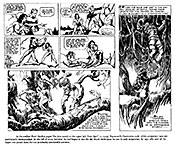 The appearance of dry-brushing, however, gave his
pictures great depth and textural beauty, and he employed the same techniques
in Jungle Jim and Secret Agent X-9. The appearance of dry-brushing, however, gave his
pictures great depth and textural beauty, and he employed the same techniques
in Jungle Jim and Secret Agent X-9.
In
the summer of 1934, Raymond began to vary the layout of the Flash page.
The strip had been designed in a four-tier format—four stacked rows of panels.
As Raymond’s imagination became more and more engaged with the feature, this
format seemed increasingly restrictive. In July, he started using an occasional
two-tier panel—a picture that spanned vertically the space of two tiers on the
four-tier grid—in order to capture more dramatically the atmosphere in which
his hero lived. A Booth-like city in the sky is pictured in one such large
panel, the increased vertical space giving the scene a dramatic impact it would
not have had in a single-tier panel. Seeing the results, Raymond quickly
abandoned the four-tier layout in favor of a three-tier arrangement that gave
him room to develop all his pictures more extensively. With the larger panels,
his backgrounds grew more lavish, and the strip’s locale acquired an authentic
ambiance. And in these spacious surroundings, the heroic posturing of his
characters lent the entire enterprise a majestic air. The world of Flash
Gordon was becoming manifestly real.
By
1936, the strip was being drawn on a two-tier grid, every panel at least twice
as large as the panels had been when Flash began. Raymond had given up Secret
Agent X-9 in late 1935, focusing entirely on his weekly page of comics. But
it was Flash not Jungle Jim that absorbed his creative energy.
The pictures in Flash were luxurient with telling atmosphere; in Jungle
Jim, as I’ve noted, they were scarcely furnished at all. By 1937, the
drawings in Flash were heavily modeled, the figures given weight and
shape by an intricate pattern of brush strokes, the backgrounds enhanced by an
extravagant latticework of shading. And still Raymond continued to develop as a
artist.
Having
reached a level of stylistic achievement unequaled elsewhere in the Sunday
funnies, Raymond went on to evolve yet another impressive style in rendering Flash
Gordon. By the end of 1938, the dry brush-like modeling and shading was
giving way to a less sketchy style. Raymond’s lines became thinner, more
continuous and graceful; his pictures were defined more by linework and less by
shading. They became exquisite tableaux, delicately rendered in copious detail.
In this period—from 1939 until 1944 when Raymond joined the marines for the
rest of World War II—Raymond’s work closely resembled Hal Foster’s in Prince
Valiant; it was the only time the work of these two great illustrators
looked much alike. 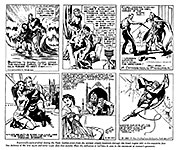
Early
in 1938, Raymond, perhaps following Foster’s lead, had begun to eschew speech
balloons in Flash, but he floated his characters’ remarks in clusters of
verbiage near their heads; a year later, he began burying speech within
quotation marks in the caption blocks at the bottom of each panel. By this
time, his storytelling technique was established. He simply illustrated bits of
narrative prose, in one superbly rendered panel after another. But the
beautiful pictures were sequentially related only insofar as they depicted
successive moments in the narrative captions. Flash Gordon had become
mostly an illustrated novel—not, exactly, a comic strip.
I
don’t mean by this to belittle Raymond’s achievements—only to pinpoint them, to
give him his due for what he actually did. And he did plenty.
That
Flash Gordon, Dale Arden, Ming the Merciless and all the rest have become a
part of the American cultural heritage is, in itself, a testament to Raymond’s
accomplishment as well as to the power of the medium. Like Sherlock Holmes
before him and James Bond afterwards, Flash Gordon leapt from the printed page
into the hearts and minds of his readers and eventually emerged on the motion
picture screen. But even before his celluloid incarnation in the 1936 serial,
Flash was already as real to his readers as it is possible for a literary
creation to be. And that was due almost entirely to Raymond, whose consumate
artistry stamped the strip, the characters, and the stories with an illusion of
reality that was more than convincing: it was spectacular.
Although
Raymond is no longer credited with single-handedly producing Flash, it
is nonetheless undeniable that it was his graphics that clothed Don Moore’s stories
in their most irresistible raiment. As Stephen Becker has observed in
his Comic Art in America (1959): “What made Flash Gordon outstanding was not the story; along the unmarked trails of intersteller space
any continuity was original. Nor were Flash and his lady friend radical
departures from the traditional hero and heroine. But Flash was
beautifully drawn.”
Moore’s
contribution, however, has been exaggerated. In his book Alex Raymond: His
Life and Art (the hands-down best book on Raymond and his art—reviewed in Harv’s
Hindsight for May 2009), Tom Roberts takes up the puzzle of how
much writing Raymond did on his strips. Although Moore has long been credited
with “writing” Flash and, Roberts says, Jungle Jim, King Features
has nothing in its files that illuminates the issue, so Roberts resorts to
published articles and other sources, making a good case for his contention
that Moore’s “writing” was much less than scripting the strips. What Moore did,
in Roberts’ judgement, was draft scripts from Raymond’s plot outlines, scripts
that Raymond then refined, tinkering with the wording and other aspects of the
narrative to suit his own sensibility. With access to the Raymond family
archives, Roberts was able to examine what little evidence survives: papers
that “show examples of Raymond writing and altering dialog for the Flash Gordon Sunday page.”
Moreover,
since Moore didn’t start working with Raymond until mid- or late-1936, Raymond
presumably wrote and scripted the strip for its first two-and-a-half years.
(For Roberts’ more persuasively detailed argument, see the aforementioned Hindsight.)
In
any case, the stories are not notably inspired. Built archetypally around Flash
as god-like redeemer (the savior from another world), the stories were
suspenseful, fast-paced, and ingenious. But for all their ingenuity of
incident, they were too fast moving to allow much time for character
development. Flash, the polo player turned savior, is everything we expect in
an adventurer—courageous, honest, nobly motivated, and above all resourceful.
But he is nothing more. Apart from possessing the traditional,
culturally-prescribed traits of a hero, Flash has no personality. His love for
Dale is perfunctory: he is the hero; she, the heroine, and the customary
relationship between such persons is love. In Dale’s pettish flashes of
jealousy (which spark with such routine predictability throughout the run of Flash),
we see all the individuality that she is allowed.
Said Coulton Waugh in his venerable The Comics (1947): “These lithe,
sexy young people have an empty look—one feels that a cross-section would show
little inside their hearts and heads.” But with Raymond’s drawing, we seldom
notice this flaw. His graphics give the strip’s characters such life-like
appearance that we overlook the absence of individual personality in them. They
are larger than life—or, at least, more beautiful, handsomer, more graceful.
And the beauty of these visuals seduces us into believing in the characters,
who look and move like we would like to look and move.
“The
total effect,” Becker said, “—slick, imaginative drawing with literate
narrative—was one of melodrama on a high level, which should not obscure the
fact that Raymond’s villains were throughly wicked or that his female
characters were generally sexy. Flash rapidly became the premier space
strip. It was wittier and moved faster than Buck Rogers; it was prettier
and less boyish than William Ritt’s and Clarence Gray’s Brick Bradford.”
There
is no question that it was Raymond’s art that brought Flash Gordon alive, his art that made the characters live in the minds of their readers. But
that art could not flourish, could not reach the luxuriance of its full growth,
in the small daily panels of Secret Agent X-9. Despite the considerable
merit of Raymond’s work on X-9, neither the format nor the subject was
amenable to the levitating magic that his art performed in Flash. And
while the format of Jungle Jim was ample enough, the subject did not
fire Raymond’s imagination as did the mythology of the redeemer in the tales of
Flash Gordon on the planet Mongo. Flash Gordon is a clear instance of
subject and artist locked in symbiotic embrace, the artist driven to achieve at
ever higher levels by his subject, the subject elevated in turn by the artist’s
endeavors.
Foster
and Raymond produced impressive works. But for all their undeniable skill as
illustrators, neither Foster nor Raymond (at this stage of his career) were
cartoonists. The works that brought them fame and earned them their niches in
the history of the medium are more akin to illustrated narratives, not comic
strips. Word and picture did not blend in Prince Valiant or Flash
Gordon in that uniquely reciprocating way that I insist defines a comic
strip. Foster and Raymond were successful illustrators—spectacularly so on the
pages of the Sunday funnies.
Still,
the physical relationship of pictures to words in Flash Gordon and Prince Valiant is the same as in the venerable single-panel gag cartoon,
and the words undoubtedly amplify the narrative import of the picture under
which they appear, and vice versa. The words don't explain the pictures as they
do in a gag cartoon: they are not the key to a puzzle that the picture
represents as captions are to the picture in a good gag cartoon. The
relationship between pictures and words in Flash Gordon or Prince
Valiant seems tangential rather than integral. In most instances of these
works, the narrative, the story, is carried almost entirely in the text. We can
understand the story without considering the pictures.
Well,
yes, but—but the pictures in Flash Gordon undeniably create the palpable
ambiance of the story; they give it sweep and grandeur. And without the heroic
elegance of its pictures, Flash Gordon is a shallow, sentimental saga.
Many children's books are not substantially different in appearance from Prince
Valiant and Flash Gordon: every page with its brief allotment of
text carries an amplifying illustration. Still, Foster and Raymond did a little
more for their narratives with their pictures than the average children's book
illustration does for its narrative. The pictures supply visual information
that fleshes out the narrative text. And the text gives nuance to the pictures.
The words and the pictures may not blend, precisely, to create a meaning
neither conveys alone without the other (as I’ve demonstrated they do in comic
strips), but their interrelationship is intimate and complementary. Within the
category of pictorial narrative, Prince Valiant and Flash Gordon are
therefore closer to being comics than they are to being illustrated children's
books. (For more in this tedious vein, consult Harv’s Hindsight for
December 12, 2005, where the whole matter of definitions is explored
tirelessly.)
With
his next creation, however, Raymond became a fully-fledged cartoonist.
RAYMOND
ENLISTED in the Marines on February 15, 1944, commissioned a captain in the
Corps’ public relations arm. His last Flash Gordon appeared May 7; Jungle
Jim, May 21. For six months in Philadelphia, he kept asking for combat duty
and finally got it: he was assigned to the USS Gilbert Islands, an
aircraft carrier in the Pacific, where, from April 1945 until the end of the
War that fall, he served as Public Information Officer, charged with observing
and documenting the life of a Marine squadron. Raymond took photographs, drew
and painted pictures and designed posters, all intended to help present the
Marine Corps in a positive light to the world beyond the Corps. He saw action
from aboard ship in the South Pacific at Okinawa, Balikpapan, and Borneo. He
was released from active duty on January 6, 1946, with the permanent rank of
major.
Raymond
expected to return to Flash Gordon and Jungle Jim, but when he
inquired about his imminent return, he was officially advised, by letter, that
he was expecting the impossible. Since he had left his comic strips voluntarily
to enlist, King Features was not obliged to hire him back to do either strip
(which would have displaced Austin Briggs, who was then doing them
both). According to Raymond relatives whom Roberts interviewed, Raymond carried
for the rest of his life a bitter resentment about being “cast off with so
little regard.”
But
King wasn’t about to let one of its stars go into eclipse: they asked him to
create a new strip, offering him a huge signing bonus, and when Raymond signed,
it was with the stipulation that he would own the new strip and receive 60
percent of the profits, not the usual fifty. Taking a suggestion by Ward
Greene, the syndicate’s general manager, Raymond developed a daily-only
strip about a detective.
A
Marine officer returning to civilian life, the title character Rip Kirby (who
was, for a time, named Rip O’Rourke) was a startling departure among comic
strip heroes: though dashing and debonair, he was an unabashed intellectual (he
even wore spectacles), moved in the best circles of society, employed a British
man servant, and had a beautiful girlfriend who was a professional model.
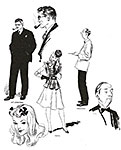 The girlfriend, a
statuesque blonde named Honey Dorian (who, in preliminary sketches, was called
Taffy), was a figment of the artist’s imagination, as almost all unbelievably
beautiful women are, but Rip and his valet Desmond were modeled by Marines
Raymond had served with. The girlfriend, a
statuesque blonde named Honey Dorian (who, in preliminary sketches, was called
Taffy), was a figment of the artist’s imagination, as almost all unbelievably
beautiful women are, but Rip and his valet Desmond were modeled by Marines
Raymond had served with.
Beginning
March 4, 1946, Rip Kirby started with a bang—a gunshot. In the four
panels of the first day’s strip, we learn that Kirby has a valet who is as much
devoted friend as servant and that Kirby is an “athlete, scientist, amateur
sleuth” and a decorated Marine reservist. Then Raymond hangs us over a cliff in
the last panel when Kirby hears a pistol shot. The rest of the opening week is
as expertly done as the first day, a tour de force of serial suspense, every
day ending with a provoking panel, and each strip telling us a little more
about Kirby. By the sixth day, we’ve got Honey Dorian to look at, and Raymond
puts her long legs on ample display while also revealing that his hero is a
musician and likes to sit at his piano (a grand piano) and noodle around on the
ivories.
Rip
Kirby is an advance in light years ove Secret Agent X-9. Raymond,
here and hereafter, is a cartoonist par excellence.
Once
again, however, Raymond worked with others in writing the strip. Here, Roberts
says, there is no doubt: the strip was concocted by Raymond in weekly story
conferences with King’s general manager, Ward Greene, who had been
writing novels in his off hours since 1929 (and would eventually produce ten of
them, including Death in the Deep South, a 1936 opus that was the basis
for the movie “They Won’t Forget” with Claude Rains and Lana Turner). Sylvan
Byck, King’s comics editor, was also part of the writing team. After the weekly
confabulation, Raymond probably did the actual scripting and dialoging of the strip.
For Rip Kirby, which, as a daily, would never appear in color, Raymond
developed yet another distinctive illustrative style, deploying solid blacks
dramatically in contrast to crisp fine-line penwork, giving the strip an
appearance that set it apart from his earlier work. Observes Roberts: “Not
having the benefit of [Sunday] color, Raymond nevertheless [colored] through
his use of varying linework ... [creating] color through contrast, though the
use of black, white and gray areas.” 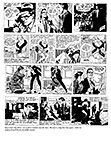
Rip
Kiby achieved rapid success, and Raymond developed a memorable series of
secondary characters, usually criminally inclined—the toothsome Pagan Lee,
competition for Honey; and the disfigured Mangler, Rip’s nemesis; and Joe
Seven, Fingers Moray, Lady Lillyput among others. Roberts feels that Raymond’s
work in Rip Kirby “inspired all the soap opera style strips of the
fifties and sixties,” from Rex Morgan to The Heart of Juliet Jones,
On Stage, Apartment 3-G, and Ben Casey—“all,” Roberts says, “are
stepchildren of Rip Kirby. Every one of these can trace its origins to
the success of Raymond’s strip.”
Raymond
worked no longer on Rip Kirby, ten years, than he did on Flash
Gordon, and he might have advanced the art of daily strip cartooning even
more had he not died, tragically, while driving fellow cartoonist Stan Drake (Juliet Jones) in the latter’s new sports car, a Corvette convertible,
on September 6, 1956. For the gruesome details of Raymond’s “last day,” consult
Roberts’ book.
Raymond’s
place in the history of his profession is established and secured by his
brilliance as an illustrator. The technical triumph he achieved in the three
strips he launched in 1934 helped establish the illustrative mode as the best
way of visualizing a serious adventure story. His work and Foster's created the
visual standard by which all such comic strips would henceforth be measured.
And
here we’ll stop, with Alex Raymond performing a tour de force of comic
strip cartooning on his last comic strip.
Return to Harv's Hindsights |